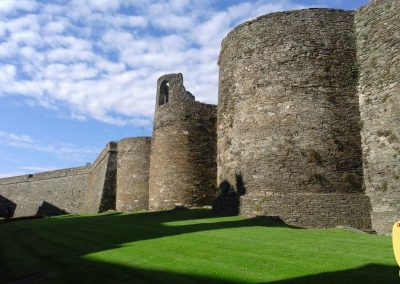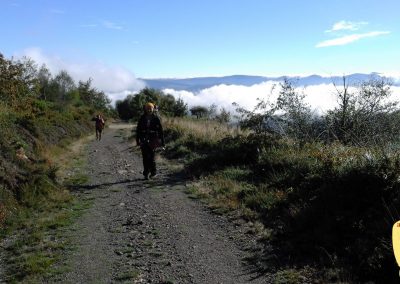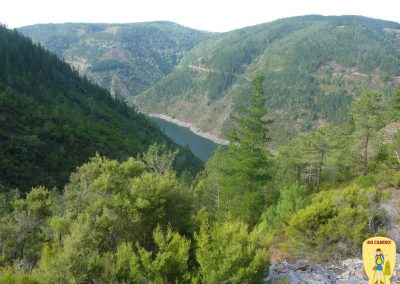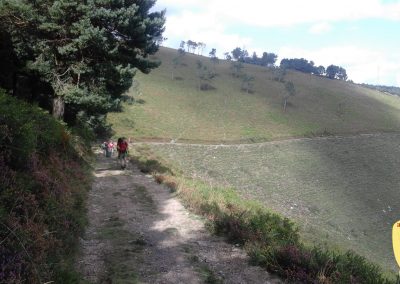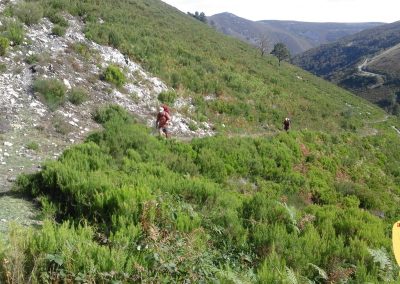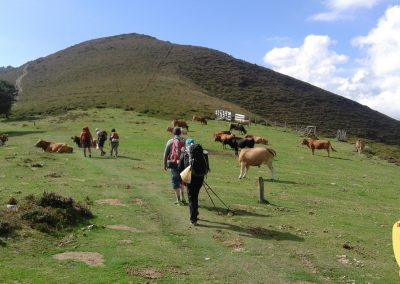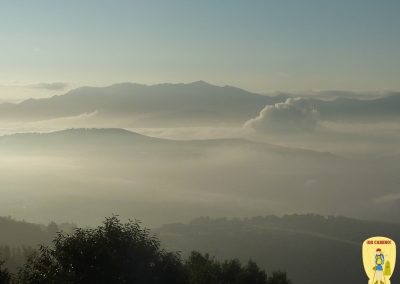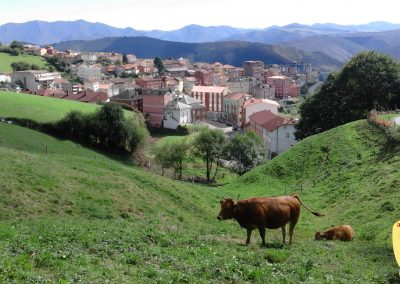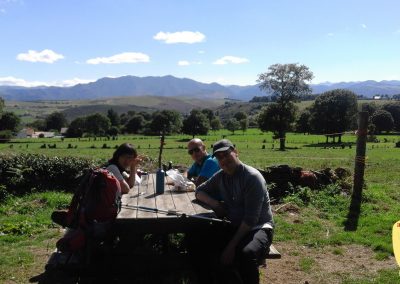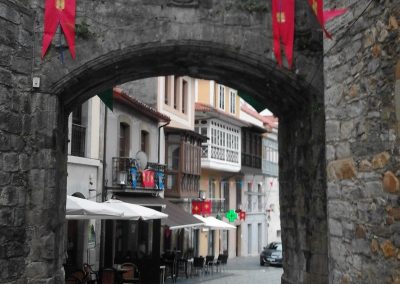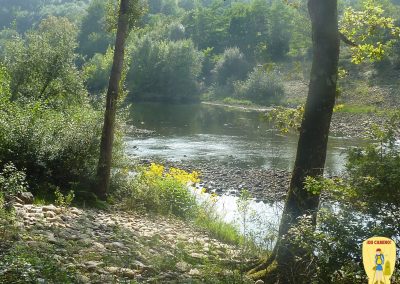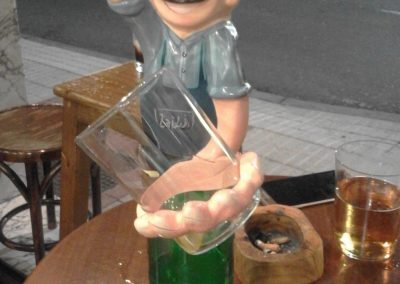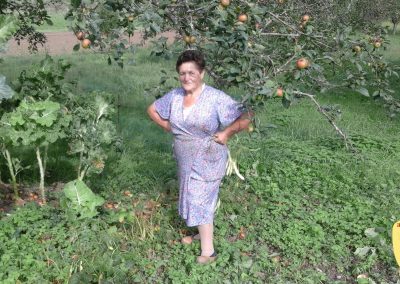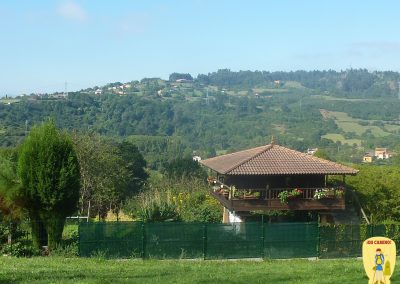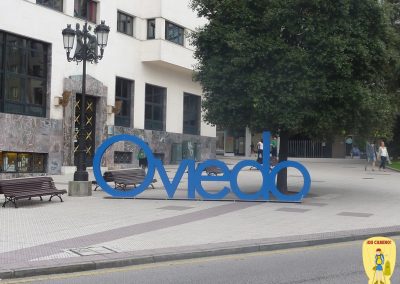
Camino Original
If you love hiking, want to be close with nature, and experience a bit of a physical challenge, then this is the Camino for you. Every little step of the Camino Original has views that will take your breath away.
The Camino Original (a.k.a. Camino Primitivo) is the original “Way of St James’’ and the oldest pilgrimage route. King Alfonso “The Chaste” is the first pilgrim in history to travel to Santiago de Compostela, creating a path of spiritual devotion that spread throughout ancient Europe and has continued until today.
Besides nature and history there are villages filled with slate roofed stone houses and pagoda-like structures called hórreos: wooden granaries raised on stone pillars to keep out the rats. Above the village hillsides sit densely wooded chestnut, pine, and eucalyptus trees.
The accommodation on this Camino is as high in quality as on any other Camino, and it is by no means “primitive” as the Spanish name Camino Primitivo would suggest. That is the reason we prefer the alternative name Camino Original.
Departure
- Self-Guided
- 15/06-29/06/24
Oviedo
In Oviedo, we will meet in a typical ‘sidrerías’ and experience how cider is poured into the glass from a great height while enjoying the local food.
The cathedral Santa Iglesia Basilica Catedral Metropolitana de San Salvador de Oviedo is the must-see highlight during a visit to the city, where we will get our pilgrim passport stamped for the first time.
The appeal of Oviedo is its old quarter housing numerous statues all over town including one of Woody Allen who is a huge fan of the city (and showcased in his hit film, Vicky Cristina Barcelona). Asturias is the only region of Spain not conquered by the Moors in the Middle Ages, it was the heart of the Reconquista and has the churches and palaces to back it up.
Day 1: Oviedo – Grado (26 km) – ↗520m↘691m
As we leave the suburbs of Oviedo, we pass through the untouched nature of Asturias (a region in northwestern Spain). We take in the astounding greenery of Asturias during our rural walk through towns such as Escamplero and Penaflor, taking in lovely views from across the valleys. Following looming mountains in the distance, we cross a Romanesque bridge over a peaceful river, along a dirt trail, all the way to Grado, our stop for the evening. Grado is a lovely town with very well preserved indiano architecture: buildings built by migrants to the Americas.
Day 2: Grado – Salas (23 km) – ↗810m↘630m
In the morning we leave Grado and head up towards San Juan de Villapañada, which was the scene of a major battle during the Peninsular War. After passing San Juan de Villapañada, we have a steep climb into Cordillera Cantabrica followed by a descent to Santa Eulalia de Dóriga, a semi-ruined monastery which was founded in 1024 in Cornellana. This part of the trail meanders through some pretty hamlets with medieval remnants, winding lanes, and the popular salmon rich waters of the Nonaya River. Finally, we arrive in Salas which is one of the best -preserved medieval village in Asturias, showcasing marble stoned pathways, a medieval tower, the palace of Valdés Salas, and the Colegiata de Santa María la Mayor.
Day 3: Salas -Tineo (20km) – ↗790m↘370m
From Salas we climb through the rainforest: surrounded by trees and ferns, the sounds of water rushing below, and a gorgeous mountain range in the distance. The climb levels out into a flat walk and finally we reach the village of La Espina. The church of Cristo de los Afligidos marks your arrival at La Pereda, with a wonderful mill and plenty of small villages that make a picturesque postcard. We stay in Tineo around town you can see views of the valley from the main plaza or visit the parish church of San Pedro.
Day 4: Tineo – Pola de Allande (27 km) – ↗836m↘958m
In the morning, we follow a dirt trail into the hills affording more amazing views throughout the gradual climb to Navariego and the mountains of Sierra de la Guardia. If the weather is nice and there is no fog, you can see the Bay of Biscay from here. At this junction, you may take a detour to the Benedictine monastery of Santa María la Real de Obona, founded in the 7th century by Prince Adelgaster. The monastery has been abandoned and is almost in ruins. Our stopping point for the night is Pola de Allande.
Day 5: Pola de Allande – La Mesa (21.8 km) – ↗1085m↘764m
Today is described as the most difficult day of the Camino, because of the physicality and also the lack of resources available on the track (food and water). We hike until we reach Borres where the route divides, 13 kilometers from here to Pola de Allande. In Pola de Allande (an old mining town) we can visit the town hall, the church of San Andrés, the palace of Cienfuegos and several other examples of Indiano architecture. There is a statue to locals who emigrated to the Dominican Republic and Puerto Rico. We climb up to El Mazo and Peñaseita. This will take you to the road leading to the Puerto del Palo – one of the most beautiful stretches in the Camino. Climbing up to Puerto del Palo is difficult at 1,100 metres high, but a fantastic challenge for the adventurous sportsman.
We continue on a mountain path with views of steep slopes and a lovely pine forest as we make our way into the village of Berducedo. We will spend the night in La Mesa.
Day 6: La Mesa – Grandas de Salime (15.7 km) – ↗965m↘1281m
We start the day with a gradual ascent to a slate-roofed chapel marking a downward path at Buspol. Down a mountainside and through a pine forest, we get our first view of the huge dammed Rio Navia. As we draw closer, we can see the dam wall at Embalse de Salime. After crossing the dam wall, we head towards Grandas de Salime – famous for gold mining and their excellent Ethnographic museum.
Day 7 : Grandas de Salime – A Fonsagrada (28,1 km) – ↗870m↘490m
From Grandas de Salime, we walk through the cute little village of Castro and the ascent to El Acebo begins. It is quite a steep climb heading to the mountain top where the wind towers are spinning away. We say farewell to Asturias as we head into Galicia. Be careful as signs for the Camino change and are now marked by the open side of the scallop shell, as opposed to our now familiar Asturian signs. There is a climb just before A Fonsagrada with stunning views, the village where we will spend the night.
Day 8: A Fonsagrada – O Cádavo Baleira (23,4 km) – ↗850m↘1070m
We pass the tiny hamlet of Padrón, and more views of the surrounding mountains, then head down a forestry road into a lovely pine forest. At the top of the mountain we find Hospital de Montouto, a former pilgrim hospital, founded in 1390 by Pedro I, the Cruel. We have a steep ascent to A Lastra, formerly owned by the Knights of St John. We also pass by an attractive town called Fontaniera, before arriving in O Cádavo Baleira, the capital of the municipality of Baleira, and our home for the evening.
Day 9: O Cádavo Baleira – Lugo (30,5 km) – ↗540m↘800m
In the morning we climb to the top of A Vaqueriza, where you can see the A Terra Cha, a plateau in the province of Lugo. This region is one of the most important milk producing regions of Europe. After that we descend towards Vilabade and enter the municipality of Castroverde, where we visit the Gothic church of Santa María, a national monument. We cross many towns on our way towards Lugo – Castroverde, Souto de Torres, Vilar de Cas, and A Pallota. The first village in the municipality of Lugo is Gondar, where the route goes up the Costa Francesa. After Bascuas, Carballido, Fazai and Santiago de Castelo, we are just a few kilometres away from Lugo.
The route to the city of Lugo runs by fountains, stone walls, crop fields, traditional houses and forests. We then come into the oldest city in Galicia, Lugo or Lugo Augusti which was founded in 14 B.C. under the rule of Emperor Augustus. The city is surrounded by the world’s largest surviving Roman walls about 2km long, 8.5m high and there are 85 round towers. The wall has been a UNESCO world heritage site since 2000. We enter the city through the Gateway of San Pedro and then head towards the welcoming Praza Maior and onto the impressive Cathedral of Santa Maria. Lugo is twinned with the Great Wall of China since 2007. The wall is now complete and you can walk around it for free.
Day 10: Lugo – Ferreira (25 km) ↗570m↘502m
The Camino leaves Lugo by the Cathedral and through the oldest gate of the city wall which is called Porta Miñá. Today we need to cross the wonderful and beautiful restored Roman Footbridge across the Río Minho. We pass by the Parroquia San Lázaro church. The horreos are now long and thin and of the Galician style, instead of the wider and square ones like we saw in Asturias.
Day 11: Ferreira-Melide (24 km) ↗369m↘436m
The trail follows ancient tracks connecting many small country villages and hamlets in the area. The route continues through Toques and into the historic town of Melide. This is where the Original Way or Camino Primitivo joins the Camino Francés. You should take the opportunity to sample ‘pulpo’ (octopus) in one of the many ‘pulperías’ (octopus restaurants).
Day 12:Melide-Pedrouzo (33 km) ↗659m↘823m
We will pass by the village of Boente where you will see the Santiago Church. You will pass the picturesque village of Ribadiso and Arzúa. Arzúa is in the heart of dairy country, make sure you try some of the local cheese. Worth visiting the church of Santa María and the church of A Magdalena in town.
Day 13: Pedrouzo-Santiago de Compostela (19 km) ↗364m↘395m
This is the final hiking day of your Camino. From Pedrouzo the Camino takes you to Amenal and on to Lavacolla. Lavacolla (also the name of the airport of Santiago) comes from the fact that pilgrims used to wash themselves in the river before reaching Santiago. We pass by “Monte do Gozo”.The hill itself is topped with an enormous sculpture commemorating the visit of John Paul II to Santiago. From here the Camino descends to Santiago de Compostela. You will enter Santiago by the bustling Rúa de San Pedro and into the old town by Porta do Camiño. You have arrived in Santiago! You will stay in a XVIth century monastery next to the cathedral of Santiago: an unforgettable experience.
¡Buen Camino!
What is included in your trip?
pilgrim’s kit containing pilgrim passport, scallop shell, packing list
transport of your luggage – limited to one transport bag during the walk
accommodation: the accommodations are right at the end of each stage so you can easily access them on your own by foot. They include private inns, hostels, and hotels and a monastery in Santiago!
your Compostela on arrival.
a unique and amazing experience you will never forget!
Number of overnight stays: 14
Number of km to be hiked: 215,7 km
Price: Ask us for a quote
Fitness level: ![]()
![]()
![]()
For this trip you must have a good fitness level.
Excluded in the price:
Flights and travel insurance are not included. Do not hesitate to refer to me for any travel related information.
The best way to travel to Oviedo, Spain:
Santander airport is served by many budget carriers, there is a direct bus from the airport by Alsa to Oviedo, passing by the Alpine landscapes of the Picos de Europa (3H25). For your return, Lugo is well connected by bus to the airport of Santiago (1H40 min).
“To arrive in Santiago like a young person, begin the Camino like an old man.”
What are you waiting for?

Camino's & Digital Detox:
Follow Go-Camino
All text and images © Copyright Go Camino and Elvira Rog.
The Go Camino logo, "Go Camino", "Digital Detox Camino, "Friese Camino" , "Camino Vino", "Camino Original" and "Camino Spiritual" are trademarks and/or service marks and/or registered trademarks of Go Camino and Elvira Rog in the Benelux and/or Spain and/or other countries.

